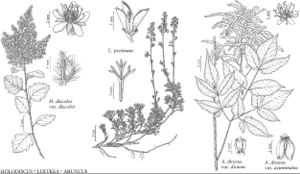Luetkea
Mém. Acad. Imp. Sci. St.-Pétersbourg, Sér. 6, Sci. Math. 2: 130, plate 2. 1832.
Subshrubs, mat-forming, 1–1.5 (–3) dm; rhizomatous, stoloniferous. Stems 1–5 (–12), prostrate, glabrous. Leaves persistent, often marcescent, cauline, alternate (internodes elongating apically), primarily crowded basally, simple; petiole present, narrowly winged; blade obtrullate, 0.5–1.5 cm, pergamentaceous, 2–3 (–5) -ternately lobed, margins flat, venation suprabasal, actinodromous, surfaces glabrous. Inflorescences terminal, 5–20 (–30) -flowered, racemes, glabrescent to villous; peduncles present; bracts reducing acropetally from 2-ternate to simple, linear; bracteoles absent. Pedicels present. Flowers 3–6 mm diam.; epicalyx bractlets 0; hypanthium hemispheric, 0.5–1 mm, glabrous or villous; sepals 5, spreading to erect, deltate; petals 5, white, spatulate to obovate; stamens 20, shorter than petals, filaments basally connate; torus thickened, 10-lobed; carpels (4 or) 5 (or 6), free, adaxially sparsely villous, styles terminal; ovules 3–5. Fruits aggregated follicles, (4 or) 5 (or 6), falcate, truncated at proximal end, 2–3 mm, sericeous adaxially; hypanthium persistent; sepals persistent, spreading to erect; styles deciduous. Seeds 1–4, elongate-fusiform. x = 9.
Distribution
nw North America
Discussion
Species 1.
D. Potter et al. (2007b), using nucleotide sequence data, grouped Aruncus and Luetkea into a subclade that was a sister group to the Holodiscus-Xerospiraea subclade; these two subclades composed a clade with strong support. A cladistic and numerical taxonomic study of Amygdaloideae (J. Henrickson 1985) using morphologic characters ascertained that Kelseya and Petrophytum were sister groups on both phenogram and cladogram; Luetkea and Xerospiraea exchanged positions depending upon the method used. In his evaluation of carpel anatomy in Aruncus (two species), Holodiscus (eight taxa), L. pectinata, and Petrophytum (four species), C. Sterling (1966) found that the combination of character states found in Luetkea was unlike those of any other of these taxa and similar only to those of some species of Spiraea. R. J. Hebda and C. C. Chinnappa (1990b) proposed two evolutionary lineages of Rosaceae based upon pollen perforation types, with Luetkea and 13 other genera in one lineage; Aruncus and four other genera formed the other. If the phylogeny proposed by Potter is correct (Aruncus and Luetkea are sister taxa), then their divergence is probably not an evolutionarily recent event; they are quite distinct in carpel anatomy and overall morphology.
Selected References
None.
Lower Taxa
"thin" is not a number."dm" is not declared as a valid unit of measurement for this property.
